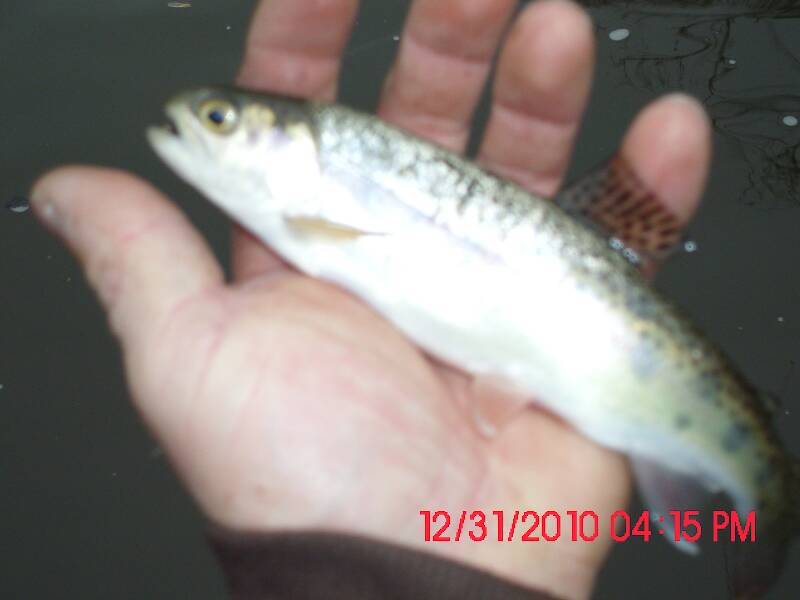
Hex Mayflies
Hexagenia limbata
The famous nocturnal Hex hatch of the Midwest (and a few other lucky locations) stirs to the surface mythically large brown trout that only touch streamers for the rest of the year.
Featured on the forum

Troutnut is a project started in 2003 by salmonid ecologist Jason "Troutnut" Neuswanger to help anglers and
fly tyers unabashedly embrace the entomological side of the sport. Learn more about Troutnut or
support the project for an enhanced experience here.
Dryfly on Dec 7, 2010December 7th, 2010, 9:20 am EST
What do you fellas think about the relation between action and casting distance?
A fast rod may cast 60 feet with ease, but if most fishing casts are under twenty would it have trouble loading and consequently have poor accuracy/slow line speed?
A fast rod may cast 60 feet with ease, but if most fishing casts are under twenty would it have trouble loading and consequently have poor accuracy/slow line speed?
SlateDrake9 on Dec 7, 2010December 7th, 2010, 11:54 am EST
Paul,
Best I can say is don’t believe everything you read. There are a lot of famous “experts” out there that have their own agendas and will represent information for particular reasons. I also believe a lot of these “experts” believe what they’re saying and a lot of it sounds pretty good. That said:
Steve Rajeff doesn’t sell any rods that aren’t considered at least fast action, so it doesn’t make any sense for him to compete with such a rod or tell folks that he could cast equally as well with a slower rod. I’d bet the farm that he could pick up a slow rod and belt out the casts he does with the fast ones – he’s just that good of a competition caster (side note, I’d be curious to see him on the trout stream and see if he can fish). I definitely agree with the line mass part. As for Lefty and Barry, I’m so unimpressed with them as people and what they represent that I’d not piss on them to put them out if they were on fire. I can’t stand what they represent (spring ridge club) and can’t get past that to even consider their opinions in any serious manner. (side note-many, many people disagree with Lefty’s opinions on bamboo rods-okay maybe not such a side note).
As for the manufacturers, I wouldn’t trust them any further than you can throw them. They’re BS experts. That is how they convince so many of us that we need to replace our perfectly good equipment with newer and “better” equipment. That is how they make their money. I stand by my statement that a competent caster can generate high line speeds no matter what rod action they are casting. Like you said, it’s about the loop unraveling and a tight loop can be easily cast with fast, slow or anything in between. All about the casters abilities.
(this isn’t directed at you – please don’t take offense) I also find that manufacturers are experts at playing on the male ego (if the nail won’t go in, get a bigger hammer instead of learning better technique) and that fast rods, to some extent, come from this. It’s evident in many, many areas that are dominated by men.
Top distance tournament fly casters all use fast rods (not a direct quote but that’s what you said). Well, no crap. Again, look at who sponsors them. Look even further-how many of those rod companies even manufacture a rod that even approaches medium, let alone slow. You won’t see some nascar driver that is sponsored by Budweiser drinking Yuengling publicly either. Same reason.
I’ll concede that graphite is lighter and cheaper, but that is the only thing graphite has over bamboo.
"""However, good bamboo rods…require more practice to master… and offer no concrete advantages, with the possible exception of the ability to present a dry fly more delicately in the hands of an expert.” (I would add "accurately" in there.)"""
Wow, what an idiotic pile of crap. Rod material has nothing to do with it. I think the author is making a common generalization about bamboo rods that they’re all slow. Yes, slow rods take some practice to get good with that isn’t generally required with faster rods (already addressed this in my first inflammatory posting-no need to repeat)
Limitations in durability of cane rods? Please share. I believe the durability limitations are with graphite rods. Strain on the glue? Maybe back when they were building with horse glue (up to the late 1920’s or so) that softened with moisture, but rods since then don’t really have any issues with glue, unless poorly built-just like any other thing.
I think there is a lot of misconceptions about bamboo rods out there that can only be dealt with through use of bamboo.
I’m sure I’ve missed some of the points I wanted to put out there, but I’m tired of typing now.
Best I can say is don’t believe everything you read. There are a lot of famous “experts” out there that have their own agendas and will represent information for particular reasons. I also believe a lot of these “experts” believe what they’re saying and a lot of it sounds pretty good. That said:
Steve Rajeff doesn’t sell any rods that aren’t considered at least fast action, so it doesn’t make any sense for him to compete with such a rod or tell folks that he could cast equally as well with a slower rod. I’d bet the farm that he could pick up a slow rod and belt out the casts he does with the fast ones – he’s just that good of a competition caster (side note, I’d be curious to see him on the trout stream and see if he can fish). I definitely agree with the line mass part. As for Lefty and Barry, I’m so unimpressed with them as people and what they represent that I’d not piss on them to put them out if they were on fire. I can’t stand what they represent (spring ridge club) and can’t get past that to even consider their opinions in any serious manner. (side note-many, many people disagree with Lefty’s opinions on bamboo rods-okay maybe not such a side note).
As for the manufacturers, I wouldn’t trust them any further than you can throw them. They’re BS experts. That is how they convince so many of us that we need to replace our perfectly good equipment with newer and “better” equipment. That is how they make their money. I stand by my statement that a competent caster can generate high line speeds no matter what rod action they are casting. Like you said, it’s about the loop unraveling and a tight loop can be easily cast with fast, slow or anything in between. All about the casters abilities.
(this isn’t directed at you – please don’t take offense) I also find that manufacturers are experts at playing on the male ego (if the nail won’t go in, get a bigger hammer instead of learning better technique) and that fast rods, to some extent, come from this. It’s evident in many, many areas that are dominated by men.
Top distance tournament fly casters all use fast rods (not a direct quote but that’s what you said). Well, no crap. Again, look at who sponsors them. Look even further-how many of those rod companies even manufacture a rod that even approaches medium, let alone slow. You won’t see some nascar driver that is sponsored by Budweiser drinking Yuengling publicly either. Same reason.
I’ll concede that graphite is lighter and cheaper, but that is the only thing graphite has over bamboo.
"""However, good bamboo rods…require more practice to master… and offer no concrete advantages, with the possible exception of the ability to present a dry fly more delicately in the hands of an expert.” (I would add "accurately" in there.)"""
Wow, what an idiotic pile of crap. Rod material has nothing to do with it. I think the author is making a common generalization about bamboo rods that they’re all slow. Yes, slow rods take some practice to get good with that isn’t generally required with faster rods (already addressed this in my first inflammatory posting-no need to repeat)
Limitations in durability of cane rods? Please share. I believe the durability limitations are with graphite rods. Strain on the glue? Maybe back when they were building with horse glue (up to the late 1920’s or so) that softened with moisture, but rods since then don’t really have any issues with glue, unless poorly built-just like any other thing.
I think there is a lot of misconceptions about bamboo rods out there that can only be dealt with through use of bamboo.
I’m sure I’ve missed some of the points I wanted to put out there, but I’m tired of typing now.
Fishing with bait is like swearing in church.
-- Slate Drake
-- Slate Drake
PaulRoberts on Dec 7, 2010December 7th, 2010, 1:31 pm EST
What do you fellas think about the relation between action and casting distance?
A fast rod may cast 60 feet with ease, but if most fishing casts are under twenty would it have trouble loading and consequently have poor accuracy/slow line speed?
Of course. Throwing a lighter line requires less rod stiffness. But there's tons of leeway there, hence the "al dente" comments. We aren't talking broomsticks and noodles here.
Ultimately, a rod would bend just enough to power the cast and come to a dead stop at the end of each power stroke. If there is too much rod pointing at/following the line at its greatest load on the cast, or when fighting a fish, that is wasted rod at that moment. Problem is not all casts are equal length and not all fish equal size. Ever seen someone fighting a fish with too soft tipped a rod? All the tip pointing straight at the fish is wasted. It MIGHT have been used to cast the line or lure, but sometimes not. It's just too wimpy a tip for that application. I got rid of a "M" spinning rod designed with too light a tip for my purposes bc it "folded up" on fish leaving me fighting them with about 4 feet of rod! Hated that.
I think you are right that accuracy is the main issue with using a rod grossly underlined –which is what casting a 60ft performer at 20ft can be. Maybe accuracy is what is really meant by the term “delicate” presentations, when describing many small stream (softer) rods. Delicate says to me minimal disturbance on the water. But that’s a matter of line and/or leader mass/configuration, and an open or under-powered loop. That can certainly be done with any rod action. But can it be done accurately?
From what one can read about fly-rod descriptions, accuracy with a stiff rod should be more critical, and difficult to achieve, a soft rod more “forgiving”. But that doesn’t appear to pan out for me. I seem to be nearly as accurate with both my 7-1/2ft 4wts (the stiff and the soft) –although the real test would be statistically casting at targets in the driveway. Regardless, I’m getting adequate accuracy with the more powerful rod and find the compact loops I get and the ability to fire further under overhangs than I can with my softer rods, a worthwhile exchange.
The stiff rod I use for small stream fishing (and that got me (in part) on this rampage), that butt ugly broken one described in my first post, is very stiff for the line I’m using on it –but it’s not a “fast” action. Interestingly, if you cut some inches off the tip of a rod the action actually becomes slower, while the power at the tip increases. This is counterintuitive to what many people think about action. The broken tip rod I fish is therefore slower in action than it was, but stiffer. It’s essentially under-lined, esp at the tip. But I cast it well, and with that rigidity it throws tight loops easily bc it provides little vertical tip travel and instantaneous recovery at the stop –a hyper stop –the prescription for tight loops. It isn't slow (line speed wise) close in, quite the opposite.
The new rod I’ve built is rated XF but that tip is surprisingly soft –taking the smallest diameter tip-top at 3.5mm. From the limited casting I’ve done in the driveway it loads and spits fine with a short line. It also creates narrow loops easily, and out a useful distance. That’s what I want. We’ll see how it performs in all aspects of small stream fishing.
So all "fast" actions aren't the same. It may be possible to have a taper that is light enough in the tip to allow for close work, but enough power further down to support distance too. I think this is what's called a "compound taper".
To build off what Steve Rajeff was saying in that interview (link above), line mass makes a big difference in terms of momentum for distance. Going up in line mass and slowing the rod action is a recipe for distance, he said. It is THE recipe for conventional distance casting -slow rods throw farther bc more rod is throwing (compounding the power). So short strokes are not necessary for distance; probably this is what SlakeDrake was noticing. But this does not mean an underpowered lever. You can have a lot of power distributed across the blank, like my stiff trout rod. Maybe a "slow" action with lotsa power is the answer there.
How is fly-casting different? You have to form a loop -beyond the rod -and a narrow loop is faster and carries more power. A soft rod (not necessarily a "slow action" one) can form a narrow loop (by tip casting) but not a very powerful one bc the power isn't there in the tip. Distance rod makers talk about "tip power" which makes sense to me from my shortened rod. It has a very powerful tip, but slow in action. Likely I might be more accurate with a softer tip -enter the compound taper -and the XF taper means that power is very close at hand.
Oh yes, another thing...in fishing small streams I'm not always throwing really short. When fish are spooky, keeping my distance can be a real help, wherever currents will allow. I fish as close as fish and currents will allow. It's nice to be able to stand up straight and cast. If it's 20feet or less, with tight cover, I often bow-n-arrow cast -another reason I want power up front. I've been using Joe Humphreys' b-n-a casting of loops of fly-line held in my hand, which gives surprising distance with no backcast. But you need to a lot of power up front to power it. Joe's small stream "workhorse" is a Fenwick HMG 7-1/2ft 6wt.
Bottom line is: My standard 4wts are too soft for me to get under and through cover with. Going up in line weight would help, but I want to see if I can do it staying with a light line -so I'm going for speed over mass. Two ways to add line speed: powerful tipped slower action or very fast action. Both are stiff, not soft. I'll see how that pans out in my fishing.
Benjlan on May 5, 2011May 5th, 2011, 6:56 pm EDT
Hey guys,
I've been watching this debate, I think everyone is right. Personally I don't like a fast rod, or even a moderate fast rod. I like slooooow rods. Lamiglas fiberglass is my preference, but I think one should fish the rod he or she feels most comfortable with. If bamboo feels good, use it. If graphite is good for you great. As long as you keep your fly out of my ear, who cares?
Ben
I've been watching this debate, I think everyone is right. Personally I don't like a fast rod, or even a moderate fast rod. I like slooooow rods. Lamiglas fiberglass is my preference, but I think one should fish the rod he or she feels most comfortable with. If bamboo feels good, use it. If graphite is good for you great. As long as you keep your fly out of my ear, who cares?
Ben
Adirman on May 7, 2011May 7th, 2011, 3:32 am EDT
Slow rods are fine on small streams but if you were in a moderate/ big river fishing situation I think you'd be pretty much forced to use a faster action rod!!
Falsifly on May 7, 2011May 7th, 2011, 10:05 am EDT
My favorite rod is the one in my hand, which recalls this question I placed to a guide years ago. I asked,” What is your favorite fish?” To which he replied, without even the slightest hint of hesitation, “the next one.”
Falsifly
When asked what I just caught that monster on I showed him. He put on his magnifiers and said, "I can't believe they can see that."
When asked what I just caught that monster on I showed him. He put on his magnifiers and said, "I can't believe they can see that."
Quick Reply
Related Discussions
Topic
Replies
Last Reply
2
Jul 5, 2009
by Pdq5oh
by Pdq5oh
8
Oct 8, 2006
by Troutnut
by Troutnut






